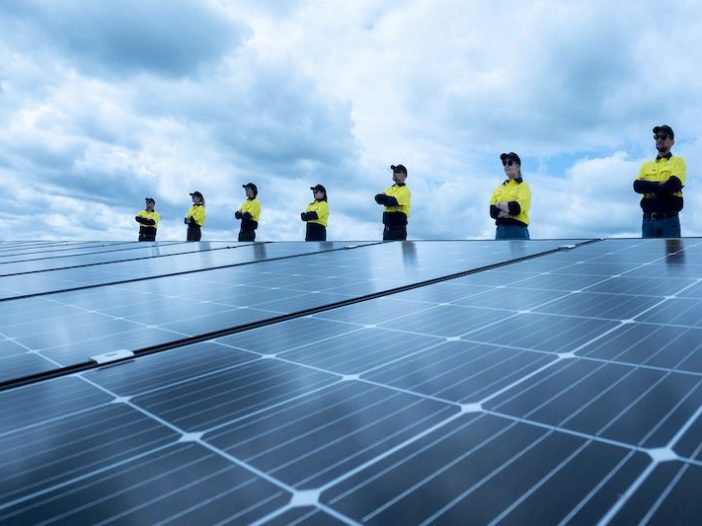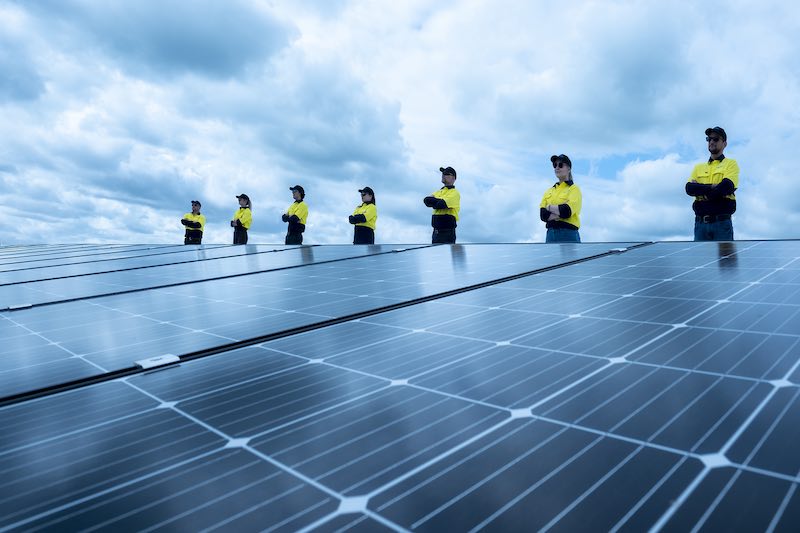
A 1.7MW “urban solar plant” built with ARENA backing to demonstrate the “tens of gigawatts” of potential for solar power generation on Australia’s industrial rooftops, has been completed and commissioned in Sydney’s west.
Epho Commercial Solar said on Thursday that the Bright Thinkers Power Station (BTPS) had been fully installed across 31,457 square metres of new warehouse rooftop owned by logistics giant DHL at Goodman’s Oakdale Industrial Estate in Horsley Park.
A key difference to this rooftop system, however, is that Epho’s BTPS technology gives it the ability to direct the solar energy generated either partially or fully to the consumer on site, or to trade directly on the National Electricity Market (NEM).
The “switching technology,” developed in partnership with Siemens works to segregate electricity through two separate channels. It does this dynamically using an algorithm based on solar PV output, electricity wholesale market and tenant demand.
Epho’s hopes to use the technology to unlock what it says is a “massive tens of gigawatt potential” solar energy generation resource currently sitting unused on industrial roofs – both for the occupants beneath the rootops and for the benefit of the greater grid.
The NSW-based company believes that installing these sort of urban power stations near metropolitan areas, where energy is needed, will play a big part in building a low-emission Australian economy.
The concept last year won interest and backing of the Australian Renewable Energy Agency, which allocated $497,000 in funding towards the design and construction of the Horsely Park demonstration plant.
At the time, ARENA CEO Darren Miller said a key potential advantage of the project would be to allow for more “smart” rooftop solar capacity to be installed on Australia’s increasingly congested grids.
Making distributed solar “smarter” and more compatible with the rest of the NEM is becoming an increasingly urgent task, including a push by the Australian Energy Market Operator – confirmed last month – for improved inverter standards for new rooftop solar PV systems, to help it gain more visibility over the increasingly hefty resource.
As RenewEconomy editor Giles Parkinson reported in April, AEMO warned that it was also seeking the ability to “curtail” rooftop solar output when needed, such were the current levels of penetration on parts of the NEM – including up to 64 per cent in South Australia.
While this push for more visibility and control over this behind-the-meter resource – via new inverter standards – has been well flagged by AEMO, it continues to be used as a flash-point in the mainstream media, when painted as a battle between average Australia suburban solar households and “the man.”
But as AEMO CEO Audrey Zibelman has explained, not having visibility or some degree of control over Australia’s millions of rooftop solar generators makes things increasingly difficult for the market operator – like having a bunch of small aeroplanes flying around in your air space but not communicating with air traffic controllers.
Solutions need to be implemented, and preferably these solutions will work for both the grid and the consumer.
With the DHL solar power station successfully commissioned in April, Epho says the BTPS has already successfully demonstrated two out of three of ARENA’s milestone funding requirements: to deliver the rooftop solar power to the building tenant under a power purchase agreement, and to distribute it via the separate connection into the wholesale market.
A third and final milestone is due in 12 months in order to review the performance of the technology over one year of operation and to complete the knowledge sharing with the wider energy and property community, the company says.
“It was absolutely wonderful to experience how a vague idea scribbled onto a whiteboard over two years ago turned into one of the most exciting new development in the distributed energy resources sector,” said Epho managing director Oliver Hartley in a statement on Thursday.
“Epho developed the BTPS concept to allow large roof-top solar systems to be connected both behind-the-meter as well as independent, market registered power stations.
“Epho’s innovation allows the entire roof area to be utilised and that the roof can be turned into a market participating urban power station,” he said.
Saul Resnick, the CEO of DHL Supply Chain Australia & New Zealand said the Epho system was primarily installed as part of a company-wide goal to achieve net-zero logistics-related emissions by 2050.
“This warehouse, purpose-built for the healthcare industry, has complex energy requirements and this system allows for flexibility. …Solutions like this one contribute to that goal and provide the best green outcomes for our customers and the community,” he said.
“Industrial solar can be rolled out quickly, grid connections can be completed in a reasonable timeframe and marginal loss factors are not an issue,” added Matt Scaddan, Epho’s head of business development.
“The question always was how we can unlock this potential and, potentially, Epho’s BTPS technology could be the key, because the technology facilitates a low-risk win/win/win situation between the customer, the landlord and the solar asset developer.”

Sophie is editor of One Step Off The Grid and deputy editor of its sister site, Renew Economy. Sophie has been writing about clean energy for more than a decade.



